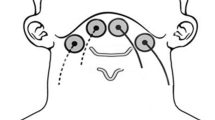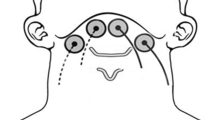Abstract
We tested two hypotheses using surface electrical stimulation in chronic pharyngeal dysphagia: that stimulation (1) lowered the hyoid bone and/or larynx when applied at rest, and (2) increased aspiration, penetration, or pharyngeal pooling during swallowing. Bipolar surface electrodes were placed on the skin overlying the submandibular and laryngeal regions. Maximum tolerated levels of stimulation were applied while patients held their mouth closed at rest. Videofluoroscopic recordings were used to measure hyoid movements in the superior-inferior and anterior-posterior dimensions and the subglottic air column position while stimulation was on or off. Patients swallowed 5 ml liquid when stimulation was off, at low sensory stimulation levels, and at maximum tolerated levels (motor). Speech pathologists, blinded to condition, tallied the frequency of aspiration, penetration, pooling, and esophageal entry from videofluorographic recordings of swallows. Only significant (p = 0.0175) hyoid depression occurred during stimulation at rest. Aspiration and pooling were significantly reduced only with low sensory threshold levels of stimulation (p = 0.025) and not during maximum levels of surface electrical stimulation. Those patients who had reduced aspiration and penetration during swallowing with stimulation had greater hyoid depression during stimulation at rest (p = 0.006). Stimulation may have acted to resist patients’ hyoid elevation during swallowing.





Similar content being viewed by others
References
Freed ML, Freed L, Chatburn RL, Christian M: Electrical stimulation for swallowing disorders caused by stroke. Respir Care 46(5):466–474, 2001
Leelamanit V, Limsakul C, Geater A: Synchronized electrical stimulation in treating pharyngeal dysphagia. Laryngoscope 112(12):2204–2210, 2002
Park CL, O’Neill PA, Martin DF: A pilot exploratory study of oral electrical stimulation on swallow function following stroke: an innovative technique. Dysphagia 12(3):161–166, 1997
Power M, Fraser C, Hobson A, Rothwell JC, Mistry S, Nicholson DA, Thompson DG, Hamdy S: Changes in pharyngeal corticobulbar excitability and swallowing behavior after oral stimulation. Am J Physiol Gastrointest Liver Physiol 286(1):G45–G50, 2004
Loeb GE, Gans C: Electromyography for Experimentalists. Chicago: The University of Chicago, 1986
Sobotta J: Head, Neck, Upper limbs, Skin. Volume 1 of Sobotta Atlas of Human Anatomy, 11th English ed. Staubesand J (ed.) Baltimore: Urban & Schwarzenberg, 1990
Wijting Y, Freed ML: VitalStim Therapy Training Manual. Hixson, TN: Chattanooga Group, 2003
Folstein MF, Folstein SE, McHugh PR: “Mini-mental state.” A practical method for grading the cognitive state of patients for the clinician. J Psychiatr Res 12(3):189–198, 1975
Rosenbek JC, Robbins JA, Roecker EB, Coyle JL, Wood JL: A penetration-aspiration scale. Dysphagia 11(2):93–98, 1996
Fleiss JL: The design and analysis of clinical experiments. New York: John Wiley & Sons, 1999, pp 1–11
Hamdy S, Jilani S, Price V, Parker C, Hall N, Power M: Modulation of human swallowing behaviour by thermal and chemical stimulation in health and after brain injury. Neurogastroenterol Motil 15(1):69–77, 2003
Burnett TA, Mann EA, Cornell SA, Ludlow CL: Laryngeal elevation achieved by neuromuscular stimulation at rest. J Appl Physiol 94(1):128–134, 2003
Pommerenke WT: A study of the sensory areas eliciting the swallowing reflex. Am J Physiol 84(1):36–41, 1927
Jean A: Control of the central swallowing program by inputs from the peripheral receptors. A review. J Auton Nerv Syst 10:225–233, 1984
Jafari S, Prince RA, Kim DY, Paydarfar D: Sensory regulation of swallowing and airway protection: a role for the internal superior laryngeal nerve in humans. J Physiol 550(Pt 1):287–304, 2003
Author information
Authors and Affiliations
Corresponding author
Additional information
The research was performed at the Laryngeal and Speech Section, National Institute of Neurological Disorders and Stroke, Bethesda, Maryland, and supported by the Intramural Research Program of the National Institute of Neurological Disorders and Stroke, Project No. Z01 NS 02980.
Rights and permissions
About this article
Cite this article
Ludlow, C.L., Humbert, I., Saxon, K. et al. Effects of Surface Electrical Stimulation Both at Rest and During Swallowing in Chronic Pharyngeal Dysphagia. Dysphagia 22, 1–10 (2007). https://doi.org/10.1007/s00455-006-9029-4
Published:
Issue Date:
DOI: https://doi.org/10.1007/s00455-006-9029-4




